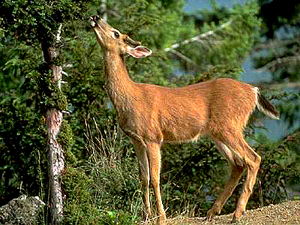Dealing With Deer
Deer and other animals that graze on vegetation, can be such a nuisance to any gardener. Our staff at Young’s have come up with some solutions that could help you and your garden thrive and survive.
We also provide a comprehensive and handy list of Deer Resistant Plants.
 If you enjoy growing leaf-type vegetables and herbs (such as lettuce, parsley and chard) but find the idea of spraying them offensive, consider the following.You can easily construct inexpensive baskets made of chicken wire under which these plants can grow. Simply take a piece that is roughly 4′x4′ and mold it around the bottom of a large garbage can or a similar form. After you have shaped it, trim the bottom edge off so that is is level, all the way around. Make sure that they are at least 10 or 12″ high so that your plants have plenty of room to grow underneath them. Attach them to the ground with wooden stakes or wire hooks to discourage deer and other animals from moving them.
If you enjoy growing leaf-type vegetables and herbs (such as lettuce, parsley and chard) but find the idea of spraying them offensive, consider the following.You can easily construct inexpensive baskets made of chicken wire under which these plants can grow. Simply take a piece that is roughly 4′x4′ and mold it around the bottom of a large garbage can or a similar form. After you have shaped it, trim the bottom edge off so that is is level, all the way around. Make sure that they are at least 10 or 12″ high so that your plants have plenty of room to grow underneath them. Attach them to the ground with wooden stakes or wire hooks to discourage deer and other animals from moving them.- Another option is to fence your property boundaries with heavy-gauge nylon mesh. This is relatively inexpensive, easy to do, and it’s very effective. Nylon mesh is also invisible from a distance, but upon closer inspection is somewhat unattractive, and may not be a good choice for open, highly viewable garden or shrub borders. The mesh should be installed in as unobtrusive a manner as possible. Attached to trees whenever possible, and use as few fencing posts as you can. Avoid using nails to attach to tree trunks, which could eventually jeopardize the health of the tree. Instead, try using self-locking plastic tie straps.Fencing should be a minimum of 7′ tall and stretched tightly. You might also consider individually wrapping your shrubs for the winter months with a lighter weight nylon mesh. This has proven to be very effective, as long as it is securely attached to the shrubs with twist ties. Nylon mesh has also been known to work well when laid flat on the ground. Deer will not walk across this barrier for fear of breaking a leg or becoming entangled. If you try this method, make sure that is is well attached to the ground and in a swath that is at least 10 to 15 feet wide.
- A final option is to use scent repellents. One of the more popular techniques is to use quartered bars of strongly scented bath soap, such as Irish Spring. These should be suspended 3-4′ off the ground and every 10 to 20 feet around the border of your garden. Short lengths of nylon stockings make the perfect baggie to hang them in. Natural tree branches are good for hanging them from, because they are more natural looking than bamboo or plastic stakes. If you opt for this technique, be sure to switch the scent every few weeks. Other than soap, you can use human hair from a barber’s shop, dried blood, Milorganite fertilizer, or scrap cloth dipped in fish emulsion. Scent repellents are not a foolproof solution, but they seem to work very well for some people. They are also quick, easy and inexpensive to make.
If you have any questions about deer repellents or deer-resistant plants, please feel free to contact us at Young’s Nurseries.


